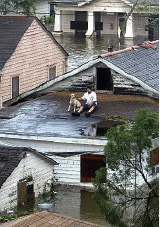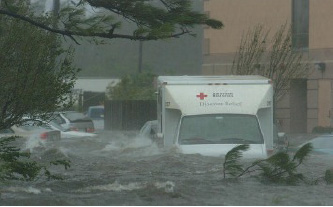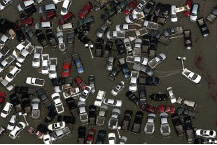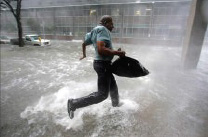
by Nora J. Baladerian, Ph.D.
Prepared for the APA Annual Convention August 2006, New Orleans, LA
August 29, 2005. In Los Angeles, California, I watched the news along with millions of others, as the hurricane warnings were aired. It was ominous. Less than a year prior, in December 2004, the terrible tsunami had hit Indonesia and Sri Lanka, with tremendous impact upon those present, and those far away. This hurricane, however, was within the USA, so I was confident a proper, prompt help to survivors would be readily available.
But then, the levees broke, flooding New Orleans! In the beginning hours, I was not too surprised to see the need for emergency rescues. But then, it continued through the night, the next day, the next night, and then for days on end. What happened? Why could we not get enough helicopters to those on rooftops? Why were hospital patients not evacuated or supplies brought in? Why were there delays? Seven days, some waited, on their rooftops, for help. Months later a landslide happened in the Philippines, and we were there within 18 hours. But we could not get help in to New Orleans. Stunned would be a good word to describe my feelings, along with aghast, disbelief and disgust.
 Slowly, ever so slowly, it seemed, help began to be made available. Various nonprofit and governmental relief agencies gained access to disaster victims. One of my friends helped with the collection and attempted distribution of donated food, supplies, clothing, first aid, animal supplies, baby supplies, which in the end amounted to about 5 truckloads. We were so excited at the response of folks to make the donations, and the truckers willing to drive to New Orleans to deliver the donations. But they never made it into the city because the government agents made them turn around. No matter how they tried to get into New Orleans, they were kept away. Later, I heard similar tales of donations made but government officials did not let the donations into the area.
Slowly, ever so slowly, it seemed, help began to be made available. Various nonprofit and governmental relief agencies gained access to disaster victims. One of my friends helped with the collection and attempted distribution of donated food, supplies, clothing, first aid, animal supplies, baby supplies, which in the end amounted to about 5 truckloads. We were so excited at the response of folks to make the donations, and the truckers willing to drive to New Orleans to deliver the donations. But they never made it into the city because the government agents made them turn around. No matter how they tried to get into New Orleans, they were kept away. Later, I heard similar tales of donations made but government officials did not let the donations into the area.
Personally, I did not do anything. At that point, I didn’t know how to help. I went on with my life. I felt conflicted. I really wanted to DO SOMETHING, but I wanted that something to make the intended difference, not have money, never provide the help I wanted to send, or provisions never arrive or to get used by those not in need. How could I do something and be sure that my help was help that was needed?
 Ecoee Rooney of New Orleans had attended my June, 2005 presentation. She asked me for more information on forensic interviewing skills to use with crime victims who have cognitive or communication disabilities. I noticed her New Orleans return address, so I briefly answered her question and further asked how she was doing. She responded politely with “thanks for the information and said they were doing fine. This I couldn’t believe, so I wrote back asking, “How are you REALLY?” This resulted in 2 pages of information on the fact that her employer, a large public Hospital, the oldest continuously operating hospital in the nation, had been destroyed.
Ecoee Rooney of New Orleans had attended my June, 2005 presentation. She asked me for more information on forensic interviewing skills to use with crime victims who have cognitive or communication disabilities. I noticed her New Orleans return address, so I briefly answered her question and further asked how she was doing. She responded politely with “thanks for the information and said they were doing fine. This I couldn’t believe, so I wrote back asking, “How are you REALLY?” This resulted in 2 pages of information on the fact that her employer, a large public Hospital, the oldest continuously operating hospital in the nation, had been destroyed.
Ecoee, a SANE (Sexual Assault Nurse Examiner) who had attended the June International SART Conference (Sexual Assault Response Team), said that their operations had been decimated. All future planning was tentative at best. She and her family had been evacuated from their home in late August. They did not know if they would have a home when they returned. I was shocked! I immediately felt I could do something to help personally. First, I put a request out on my listserve (www.cando@disabilityabuse.com) to send any educational or supportive materials to Ecoee to give to her patients who had survived sexual assault.
Then, I asked if Ecoee would allow me to come to New Orleans, at an appropriate time, to do some trauma work with the hospital staff (wherever they might be). She was ecstatic, amazed, appreciative, grateful, welcoming. She asked exactly what type of trauma treatment I was suggesting. So I explained Thought Field Therapy to her as basically the application of acupuncture/acupressure therapy to psychological matters such as trauma, grief, bereavement, anxiety, among others, using tapping on the points rather than piercing or painful rubbing. She forwarded my explanation to the “higher-ups” in the medical administration who then requested additional information I answered them and they responded with an enthusiastic “Yes”. I then let some of my TFT trained colleagues know I planned a one week aid visit to New Orleans. I was hoping to provide as much TFT trauma therapy as possible to Ecoee’s hospital staff and the staff at Ecoee’s partner’s place of work, the Volunteers of America supported living program for individuals with disabilities. Her partner, Melody, helped evacuate the VOA clients and was now returning them to the community and they all needed trauma work.
I also received an email from a colleague in Louisiana tentatively asking if “while in New Orleans”, I could provide a free training to his APS (Adult Protective Services) staff on Forensic Interviewing and Assessment of Consent to Sex for forensic cases involving individuals with developmental disabilities. “Sure, I’ll be there anyhow, and why not also add to the program trauma treatment for them?” I responded.
 With the help of the ATFT Trauma Relief Committee chairperson, Norma Gairdner, H D, TFT-Dx, in Toronto, Canada, twelve trauma therapists from 7 states (Hawaii, Washington, California (3), Arizona (2), Colorado, South Carolina, Mississippi and Louisiana(3) were recruited to form our team. We ended up calling ourselves a “Dream Team” because we worked so well together. We worked and lived together as if we had all known each other for years, without any conflict, or negatives whatsoever. Each had her/his own gifts, approaches, styles, to be sure. And each practitioner respected the other, learned from each other, and supported one another. It was truly magical.
With the help of the ATFT Trauma Relief Committee chairperson, Norma Gairdner, H D, TFT-Dx, in Toronto, Canada, twelve trauma therapists from 7 states (Hawaii, Washington, California (3), Arizona (2), Colorado, South Carolina, Mississippi and Louisiana(3) were recruited to form our team. We ended up calling ourselves a “Dream Team” because we worked so well together. We worked and lived together as if we had all known each other for years, without any conflict, or negatives whatsoever. Each had her/his own gifts, approaches, styles, to be sure. And each practitioner respected the other, learned from each other, and supported one another. It was truly magical.
We stayed in Ecoee and Melody’s house. They had only returned home one week prior to our arrival! They moved out to the FEMA trailer that had been placed in their backyard for Melody’s Mom, and let 9 of us stay in the house (the other 3 were living locally in New Orleans).
In these circumstances, flexibility is a must. The team members arrived ahead of me because my luggage got lost and my flights got delayed so I chose to rent a car and drive from Atlanta, Georgia to New Orleans the next day. Tuesday had been planned for a “tour” of the city. We all brought our cameras. We traveled in Ecoee’s SUV and a van loaned to Melody for the week by Volunteers of America, to support the trauma team. What generosity. We went on the tour. We saw not blocks but miles of uninhabited and uninhabitable neighborhoods… houses that had slid off their foundations, floating away, but stopped by another house or a tree. Lots of cars on top of houses. Furniture halfway out of windows which the locals called “vomiting”. Miles and miles and miles of complete destruction. Sad. Desolate. Unbelievable. Although we were seeing it, I noticed I was having trouble believing my eyes. Each house had an X with information in each quadrant, the top noting the date that someone was there to inspect …dates like 9-10, 9-22…nearly a full month after the storm was the FIRST visit for emergency assistance. The destruction of the homes was complete…this is now four full months after the storm, and it appeared that nothing had been done at each home. Nothing. What could anyone do? Little help was available. No one could live in the area. Trash pick-up was just beginning. It was hard to drive in the area. We saw where the levee broke. We saw tent-city, where folks had set up tents. We even saw near the airport several hundred trailers not yet distributed. Waiting. We then went to dinner together, and came home to plan our trauma intervention work at the hospital the next day.
Charity Hospital was housed in military tents at the Convention Center. There was a dentistry tent, triage tent, SART tent, among others. It was eerie. It was strange. We worked in the training tent, with a generator going for the air conditioning. Hospital staff could only take one hour for participation, so we had planned 5 hours, 10,11,12,1 and 2pm. The process was to provide a twenty minute informational talk on trauma and Thought Field Therapy, followed by forty minutes for participants to experience trauma treatment with a TFT practitioner. The first hour included the hospital administrators as participants. They had approved our presence there in the first place. Highly meaningful was Dwayne Thomas, MD, Chief Executive Officer’s participation in both the training and the trauma relief session. They were astounded, and pleasantly surprised at the fact that TFT made an actual difference in how they themselves felt. Each of the individuals was asked to complete a post-treatment evaluation and they were given a copy of Stop the Nightmares of Trauma, a book written and donated by Roger J. Callahan, Ph.D., TFT’s founder. We noticed that each hour, more and more people came. At 3p.m., people kept wandering in. Some curious; some hesitant, all wanting to feel better, or just wondering how this TFT works. More came. We did not leave until around 5:30 P.M.
Ecoee then took us all to a restaurant for dinner, where she read the evaluations and she received a phone call from one of the doctors, asking if we could possibly return on Saturday, since the residents he supervised missed the training and now were asking for an opportunity to try this trauma treatment! We were ecstatic, principally because of the fabulous results we had already experienced, but also because there are times when our work is not recognized for the fantastic results it can produce, and here we had a request to return! The evaluations were all we could have hoped for. Many comments were essentially, “I have been feeling hopeless, depressed, and now I am feeling that I’ve had a huge burden lifted…THANK YOU for this. I am amazed that this simple procedure has such a profound effect. And it has changed my friend as well, and this is so important to me”. At the conclusion of dinner, Ecoee announced that the folks at the hospital had given her money to pay for our dinner. Wow.
Because during the treatment, the clinician demonstrates to the client where to tap, we had been tapping upon ourselves all day, and we noticed that we were all feeling fine, unaffected by the traumas we had witnessed both directly and indirectly.
The following day we all went to the Volunteers of America program and worked with their staff, who all had a similar reaction. So grateful to have relief from the traumatic symptoms they had been living with now for months. So amazed that this simple procedure is so powerful.
Friday we worked with the APS folks, and Saturday we returned to the hospital. We were all so excited to be able to DO SOMETHING OF VALUE in our own country, and those in New Orleans were SO GRATEFUL to have 12 people taking their own time and at their own expense to come to their city to help. They were amazingly appreciative, and said that many feel forgotten, as there are no more headlines or even news articles about New Orleans.
By the end of the trip, our hosts, Ecoee and Melody had done quite a bit of TFT tapping for themselves and were now avid endorsers of this trauma therapy. The beauty of TFT had convinced them. The following factors are the ones that tip the balance:
1. It works
2. The results last
3. It works fast
4. There is no emotional (or physical) pain induced during the treatment
5. There are no side-effects
6. Anyone can learn how to use TFT
7. It has many applications
8. It is voluntarily given!
These are all really excellent factors, and ones in which any healing practitioner would be interested.
Of the 187 evaluations, we had asked people to rate their level of distress pre- and post treatment. The average pre-treatment rating (on a scale of 0-10, ten being the worst, 0 no distress), was 8.03, and the average post-treatment rating was 0.57.
 Overall, this was one of the most rewarding experiences of my life. My TFT colleagues, the folks in New Orleans, our hosts Ecoee and Melody who are now members of my chosen family, all made this a wonderful experience. I returned again in February, doing some TFT work in Baton Rouge and in New Orleans on my own, and returned with another team of 12 in March 2006, with another week of healing, and this time, teaching an enthusiastic class of individuals how to administer TFT themselves. This is really a wonderful outcome, to empower folks to be able to learn TFT themselves, so they can continue the healing work as needed.
Overall, this was one of the most rewarding experiences of my life. My TFT colleagues, the folks in New Orleans, our hosts Ecoee and Melody who are now members of my chosen family, all made this a wonderful experience. I returned again in February, doing some TFT work in Baton Rouge and in New Orleans on my own, and returned with another team of 12 in March 2006, with another week of healing, and this time, teaching an enthusiastic class of individuals how to administer TFT themselves. This is really a wonderful outcome, to empower folks to be able to learn TFT themselves, so they can continue the healing work as needed.
Because of the invitation to participate on a panel of speakers at the American Psychological Association’s Annual Conference in New Orleans on “Responding to Katrina: Personal Perspectives”, I brought another team in to New Orleans for the week. The weekend before the APA conference, we held TFT training at Ochsner Hospital, teaching 60 professionals from a variety of agencies from Louisiana and Mississippi. Then, during the week, we again provided trauma treatment to many individuals at a variety of agencies and organizations throughout the city. At this time, we are only selecting licensed mental health professionals to join our team who are Certified in Thought Field Therapy. For those wanting to join us on a future trip, these are the criteria along with others that will be clarified for those who apply to join our team.
I would return to New Orleans and conduct Trauma Therapy again in a heartbeat. And, all those who joined me there are of the same mind, and commitment, to return as needed. Thanks to those of you for sharing with me the excitement of being able to bring true healing to hundreds of individuals in trauma.
